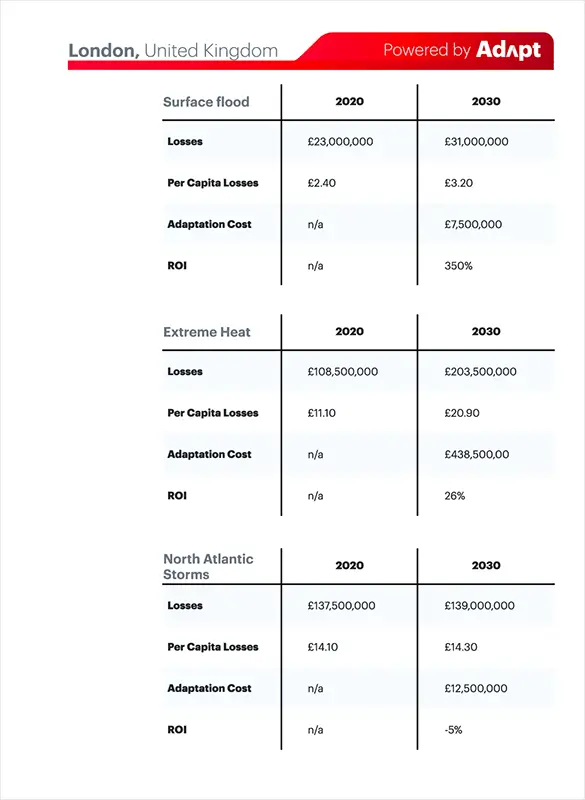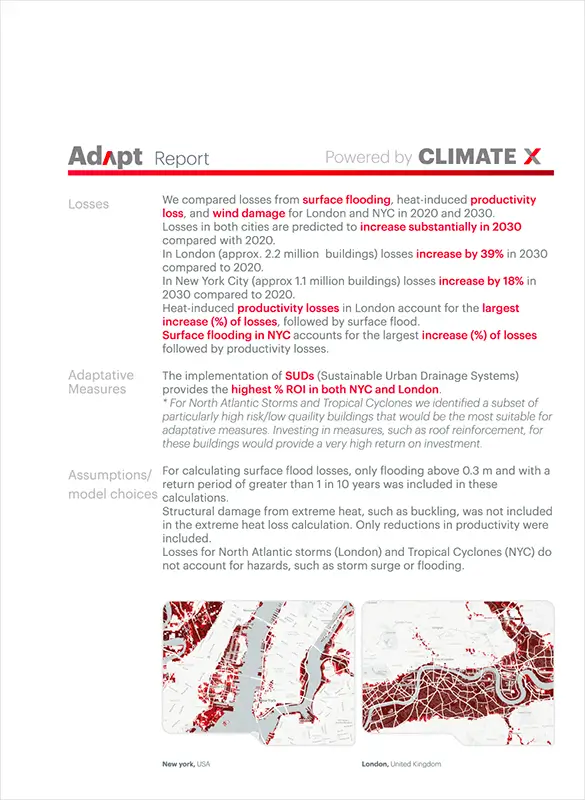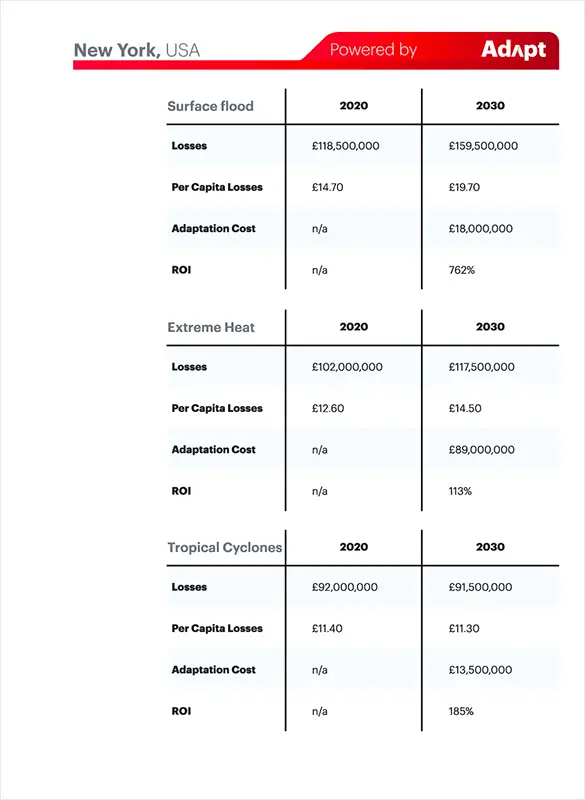
Identify climate adaptation CapEx requirements in minutes without third-party dependencies.
Traditional on-site assessments take time and resources, potentially costing you valuable deals.
Adapt provides instant access to asset-level climate risk data and forecasts return on investment (ROI) for planning and implementing adaptation solutions.
Become hyper-reactive by speeding up transaction closures, building asset resilience and outpacing your competition confidently.

Climate Adaptation / Resilience Platform
De-risk Assets' Physical Risk through Climate Adaptation
Accurate climate risk and adaptation planning data - readily available.
Integrate Climate Adaptation to your Investment Cycle with Climate X Adapt and the convenience of on-demand data.
In few clicks, you can run a full risk assessment, explore adaptation options and download the data in a .csv file.
No need for costly consultants which can slow down deals.
Quickly progress through your Acquisition or Due Diligence process with Adapt, saving time and resources.
Simply log in and access the data you need to make decisions - fast.
No 3rd Party Assessments
On-demand Adaptation Data & ROI
Based on ISO Guidance
Data you need, faster, with fewer resources
Adaptation reports in minutes.
The outdated approach to assessing climate adaptation measures involves leveraging a team of consultants. Projects can take weeks to mobilise, resulting in deal slowdowns or loss of deals altogether.
Generate a climate adaptation report in as little as 60 seconds with our easy-to-use tool, Adapt.
You can access the web application on demand, upload your asset and download the data you need for an Adaptation report – in a minute or so.
Existing/Typical Adaptation Process Flow

vs
Adapt Process Flow

Climate Mitigation SaaS Platform
Strategic insights, in one document
A concise overview of adaptation potential.
For your asset, Adapt's downloadable .csv report includes:
- Pre-adaptation risk assessment metrics.
- Adaptation implementation costs, 1-year and 10-year ROI, and loss savings.
- Post-adaptation risk assessment metrics.
Leverage these insights to identify undervalued assets, finding hidden opportunities faster than your competitors and without relying on external consultants.




ISO-guided Climate Adaptation
Make sustainable and resilient investments.
Our platform was built with rigourous compliance in mind - based on ISO 14090/14091, as well as UNFCCC, EU Taxonomy and Technical Guidance.
Our recommendations are aligned with the above regulations, so you can ensure compliance and drive resilience in your portfolio.
A Leading Climate Adaptation Solution
Leverage Adapt for valuation calculations, new adaptation financing opportunities and even insurance negotiations.
Get a competitive advantage during the Acquisition / Due Diligence Process
You no longer need to liaise with external consultants or surveyors to evaluate climate risks.
Our climate solutions offer the convenience of direct data access without the need for intermediaries.
How it works:
- Upload your asset to assess its physical climate risk and potential financial losses.
- Customise up to 44 building parameters (such as exposure and sensitivity).
- We identify suitable adaptation measures among the 21 available so you can review their financial cost, one-year return, and ten-year return on investment (ROI).
- Share these insights with a downloadable .csv report, which includes pre and post-adaptation financial losses.
Save time while optimising costs and discovering new revenue opportunities such as targeted adaptation financing.
Climate Adaptation Tool Features
- 21 Climate Adaptation Measures available for each asset
- Classified by hazard, presented based on risk profile and return.
- Customisable parameters for building exposure (premise area, number of floors, etc.), sensitivity (asset use, roof type, wall type, etc.), adaptive capacity, and more. These features are pre-populated; however, you can override the 44 parameters to increase accuracy.
- Available via web application.
For each Climate Adaptation Measure, we provide:
- Implementation costs
- Loss Savings
- One year ROI
- Ten year ROI
Finally, adaptations are implemented, and the risk profile is adjusted.
Rooted in academia and in International Organisations' directions
Our physical risk hazard library and approach fully align with EU Taxonomy and NGFS guidelines.
For our Physical Risk library:
-
11 Physical Risks: includes river flooding, surface flooding, coastal flooding/sea level rise, subsidence, landslide/coastal erosion, wildfire, North Atlantic storms, tropical cyclones, storm surge, extreme heat stress and drought/water stress.
-
Multiple scenarios, 80-year span: RCP 2.6, 4.5, 6.0, & 8.5 + SSPs 1, 2, 3, 5; in as little as 5-year intervals from 2020-2100.
For our Climate Adaptation approach:
Our Climate Adaptation framework is grounded in academic literature, UNFCCC, EU Guidance and Taxonomy, and ISO standards.
It's important that the implementation aligns with guidelines like the DNSH Principle (Do No Significant Harm principle) to meet EU taxonomy standards.
While we offer some guidelines and considerations to ensure compliance during implementation, our primary focus is supporting the planning of adaptive measures rather than their execution.
Use Cases
Get a competitive advantage during the Acquisition / Due Diligence Process
You no longer need to liaise with external consultants or surveyors to evaluate climate risks.
Our climate solutions offer the convenience of direct data access without the need for intermediaries.
How it works:
- Upload your asset to assess its physical climate risk and potential financial losses.
- Customise up to 44 building parameters (such as exposure and sensitivity).
- We identify suitable adaptation measures among the 21 available so you can review their financial cost, one-year return as well and ten-year return on investment (ROI).
- Share these insights with a downloadable .csv report, which includes pre and post-adaptation financial losses.
Save time while optimising costs and discovering new revenue opportunities such as targeted adaptation financing.
Features
Climate Adaptation Tool Features
- 21 Climate Adaptation Measures available for each asset
- Classified by hazard, presented based on risk profile and return.
- Customisable parameters for building exposure (premise area, number of floors, etc), sensitivity (asset use, roof type, wall type, etc), adaptive capacity and more. These features are pre-populated, however you can override the 44 parameters to increase accuracy.
- Available via web application.
For each Climate Adaptation Measure, we provide:
- Implementation costs
- Loss Savings
- One year ROI
- Ten year ROI
Finally, implement adaptations and adjust risk profile.
Framework
Rooted in academia and in International Organisations' directions
Our physical risk hazard library and approach fully align with EU Taxonomy and NGFS guidelines.
For our Physical Risk library:
-
11 Physical Risks: includes river flooding, surface flooding, coastal flooding/sea level rise, subsidence, landslide/coastal erosion, wildfire, North Atlantic storms, tropical cyclones, storm surge, extreme heat stress and drought/water stress.
-
Multiple scenarios, 80-year span: RCP 2.6, 4.5, 6.0, & 8.5 + SSPs 1, 2, 3, 5; in as little as 5-year intervals from 2020-2100.
For our Climate Adaptation approach:
Our Climate Adaptation framework is grounded in academic literature, UNFCCC, EU Guidance and Taxonomy, and ISO standards.
It's important that the implementation aligns with guidelines like the DNSH Principle (Do No Significant Harm principle) to meet EU taxonomy standards.
While we offer some guidelines and considerations to ensure compliance during implementation, our primary focus is supporting the planning of adaptive measures rather than their execution.
Frequently Asked Questions
Based on the UNFCCC, climate adaptation refers to making changes to ecological, social, or economic systems to prepare them to deal with the current impacts of climate change.
Climate adaptation is important as it represents actions we can take now to lessen the negative effects of climate change.
In the context of the built environment (real estate), climate adaptation refers to investments that can lower the physical damage from extreme weather events.
For example, an asset facing high risk from North Atlantic Storms or Tropical Cyclones wind (Windstorms, Hurricanes) could benefit from roof bracing or storm shutters as adaptation measures.
With Adapt, you can see the cost of implementing these measures, how well they protect against risk, and the resulting damage prevented (loss savings).
Using this data, we calculate the return on investment (ROI) of the adaptation.
Ready to hear more about how this innovative tool can speed up your investment cycle and open new revenue opportunities?
Talk to Sales today
Our Latest Articles & News
A selection of some of our latest articles covering industry, policy and climate science - written by us.
CBRE expands Climate Risk assessment capabilities with Climate X agreement
CBRE today announced expanded capabilities to provide climate risk data for property investors and occupiers to accelerate sustainability planning, reporting and decision-making.





















